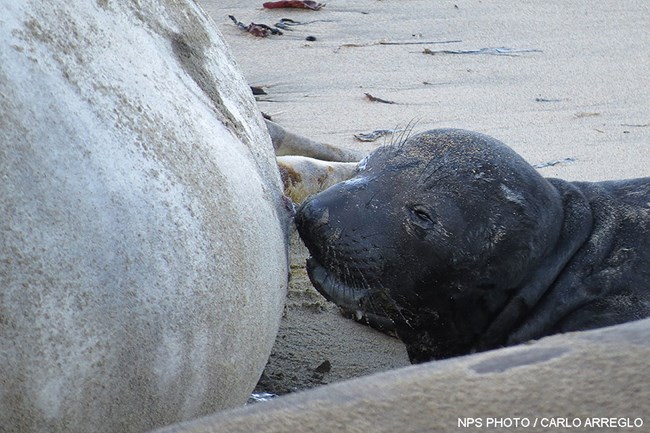Part of a series of articles titled Elephant Seal Tales.
Article
December: Male Elephant Seals Arrive—and Let Us Know They Are Here
Elephant seals make a LOT of noise! Anyone who visits either the Elephant Seal Overlook at Chimney Rock (when the road opens) or Drakes Beach in December will be struck immediately by the racket that raucous male elephant seals make. At first, the cacophony sounds like a random assortment of burps and belches, clicks and snorts. But the vocalizations are not random—they are, in fact, a complex and essential element in establishing hierarchy.
- Duration:
- 7.975 seconds
An eight-second video clip of a bull elephant seal vocalizing at Drakes Beach on March 9, 2019.
Though female elephant seals won't arrive on Point Reyes beaches to give birth to their pups until January, the bulls (adult males) are arriving now, ready to do battle, both physically and vocally, to determine which among them is an alpha male who will get to establish a harem and to mate with and impregnate the most females.
Neither the vocalizations nor the fighting is haphazard. Scientists have known for some time that seals in the same community recognize each other's vocalizations as representing either a male to avoid or a male who might be defeated in a battle. In a sense, if they live in the same neighborhood, they speak—or is it snort?—the same language. When they are snorting or clicking or otherwise vocalizing, they are, in fact, announcing their identity to community members that can then use that knowledge to decide whether to submit or attack them.
But why do elephant seals spend so much time snorting and clicking? Why don't they just fight? The answer is clear once we recall that elephant seals do not eat or drink while they are on land. As a result, they want to avoid energy-consuming physical battles. Remember, mature male elephant seals can weigh more than 4000 pounds, and lugging around that quantity of blubber on land takes a lot of energy. So, their vocalizations are a kind of proxy for the startling battles that mesmerize human onlookers.
The research of Dr. Caroline Casey, an expert on elephant seals from the UC Santa Cruz Pinniped Lab, reveals that not only are the males' vocalizations not random, other males in their community recognize their ritualized displays and sounds. Amazingly, based on previous interactions with their rivals, the bulls remember the calls they hear and react accordingly. A rival that had defeated them in the past prompts a retreat, while the calls of a rival they had defeated evokes aggressive behavior.
Point Reyes National Seashore volunteers can offer invaluable and dramatic first-person accounts of elephant seals' behavior. In a recent conversation, Jeff Wilkinson, an experienced Winter Wildlife Docent at Point Reyes, observed that, though physical fights between male seals rarely last more than five minutes, "these fights end up in the water very quickly. The 'big boys' overheat rapidly and need the water to cool down!" Kent Khtikian, another volunteer who has been tagging and surveying elephant seals for several years, witnessed a longer confrontation between two males, a clash that included their fighting on the beach and in the water. After a long battle, the victor dragged himself out of the water and onto the beach, bloodied and exhausted, to reassert his position as the dominant male in his harem. His rival did not return to the beach.
On a calmer and sweeter note, Faith Fisher, another volunteer, tells a hilarious story of being sure she is hearing the roar of a Harley Davidson night and day outside the Lifeboat Station where she is spending the night after her shift as a Winter Wildlife Docent—only to discover that she is hearing the trumpeting of a male elephant seal! She imagines he is rehearsing for future confrontations.
Even after the bulls seem to settle—through vocalizations or physical battles—which among them are the alpha males, they remain on high alert throughout the season, scaring off other males who might try to come onto the beach. And, of course, the males have to wait to get down to the business of mating because female elephant seals will be busy giving birth and nursing their pups for the first month of 2021.

Our January installment will focus on the birth of the pups, and their nursing and startlingly-rapid growth. Teaser: the fat content of elephant seals' mothers' milk increases during the course of the season!
Then, the Valentine's Day edition will focus on the mating that follows almost immediately after the females wean their pups, though some females will mate with the alpha male while they are still nursing their pup.
Some things to think about: will it be just the alpha males who get to mate? And how do females protect themselves and their pups before they are ready to mate?
Because the pandemic is keeping Point Reyes National Seashore Docents from doing what they love best—interacting and explaining seals' behavior to the public—upcoming articles will attempt to provide month-to-month information and reflections on what all the activity means, including more anecdotes and interpretation by volunteers!

Be sure to check back for each update. And, if you find the volunteers' on-the-scene anecdotes tantalizing, visit our Point Reyes National Seashore's Volunteer page to learn more about volunteering and making a difference!
By Ellen Greenblatt, Point Reyes National Seashore Volunteer
Last updated: January 22, 2021
